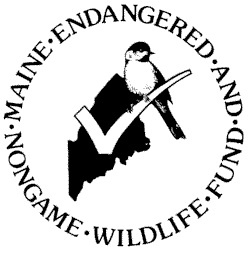This story was updated at 9:25 am 2/2/13 to correct the year of filing state income taxes
Maine’s state bird – the chickadee – may soon lose its fundraising spot on state income tax forms.
Unless more taxpayers opt to use the “chickadee check-off” option when filing their 2012 state income taxes, that method of raising money to help support the Maine Endangered and Nongame Wildlife Fund is likely to end, said officials with the Department of Inland Fisheries and Wildlife.
“If we drop below the threshold of $25,000,” the check-off will be eliminated as an option on the tax form, said Doug Rafferty, director of public education and information with the state Department of Inland Fisheries and Wildlife. “And we certainly don’t want that to happen.”
The chickadee was chosen as the symbol of the program, because “it’s the state bird and everybody loves chickadees,” said Charlie Todd, biologist and endangered species coordinator for Inland Fisheries and Wildlife. “Maine citizens have long identified with the chickadee.”
The check-off option was added to state tax forms in 1983, according to information on the state’s website. It proved popular, generating more than $129,000 in donations from taxpayers in its best year — 1985 — and for a decade it was the sole source of funding for endangered species programs in Maine except for limited federal money, the state’s website says.
The check-off was supplemented by the loon license plate conservation registration in 1994, which raised more than $617,000 for nongame and endangered species programs in its best year, 1998.
The funding raised by both programs has dwindled. In 2005, the last year for which records are provided on the state’s website, the loon plates raised almost $382,000 and the chickadee check-off raised almost $37,000 in tax return contributions. Contributions from the loon license plates and the chickadee check-off totaled $311,459 in fiscal 2112.
Losing the check-off funding would hurt.
Every dollar contributed through the check-off brings in an additional $3 to $4 in matching federal funding, meaning the loss of the baseline $25,000 would translate into as much as $100,000 lost for endangered species and wildlife programs in Maine, Rafferty said.
What has happened to the chickadee check-off is typical of what wildlife and conservation organizations and agencies are finding across the nation, Todd said. Sufficient, stable funding for programs to protect wildlife diversity and endangered species is difficult to generate even in the best of times, he said.
Mainers have traditionally supported such programs more generously than taxpayers in other states.
“But it’s a struggle,” he said, “especially in rough times.”
The chickadee check-off program has been in trouble for at least a decade, said Rafferty. In 1998, it suffered a severe blow when the check-off box was moved from the primary tax form to a separate form for charitable contribtions — Schedule CP.
The primary tax form still had a line to record total contributions, but the amount taken in dropped 40 to 50 percent, and by 2004 only 0.06 percent of Maine taxpayers were still contributing, down from about 5 percent during the 1980s.
In addition, the chickadee check-off has been joined on income tax forms by several other check-off donation options, including the Companion Animal Sterilization Fund, the Maine Children’s Trust Inc., the Bone Marrow Screening Fund, the Maine Military Family Relief Fund, the Maine Veterans’ Memorial Cemetery Maintenance Fund and the Maine Asthma and Lung Disease Research Fund.
“The pie is only so big with these funding sources,” Todd said. And with so many contenders, “there’s been kind of an avalanche” of competition.
On the upside, average donations have increased steadily from $4-$5 in the 1980s to more than $13 in 2004, according to Inland Fisheries and Wildlife information provided by Caroline Hailey, public relations representative for the department.
If 3 percent or 4 percent of Maine taxpayers participated in the chickadee check-off at the higher donation average this tax season, it would raise $220,000 to $300,000, the department estimated.
Some of the projects funded by the tax-form check-off and loon plate programs include population surveys, habitat protection and research on the effects of pollution on bald eagles; studies to monitor Blanding’s turtle and spotted turtle habitat and population; surveys of piping plovers, least terns and roseate terns, as well as programs to protect their nesting colonies and habitat, Todd said.
Especially valuable, he said, has been the compilation of years of data on endangered species collected in the Biological and Conservation Data System, a nationally standardized, comprehensive database that enables partnerships among states in wildlife conservation efforts.
Just what might replace the check-off if it is eliminated is not yet known, Todd said.
“We’re approaching extinction as time marches on,” he said. State officials will have “to take a step back and kind of regroup.”
Staff Writer North Cairn can be contacted at 791-6325 or at:
ncairn@pressherald.com
Send questions/comments to the editors.


